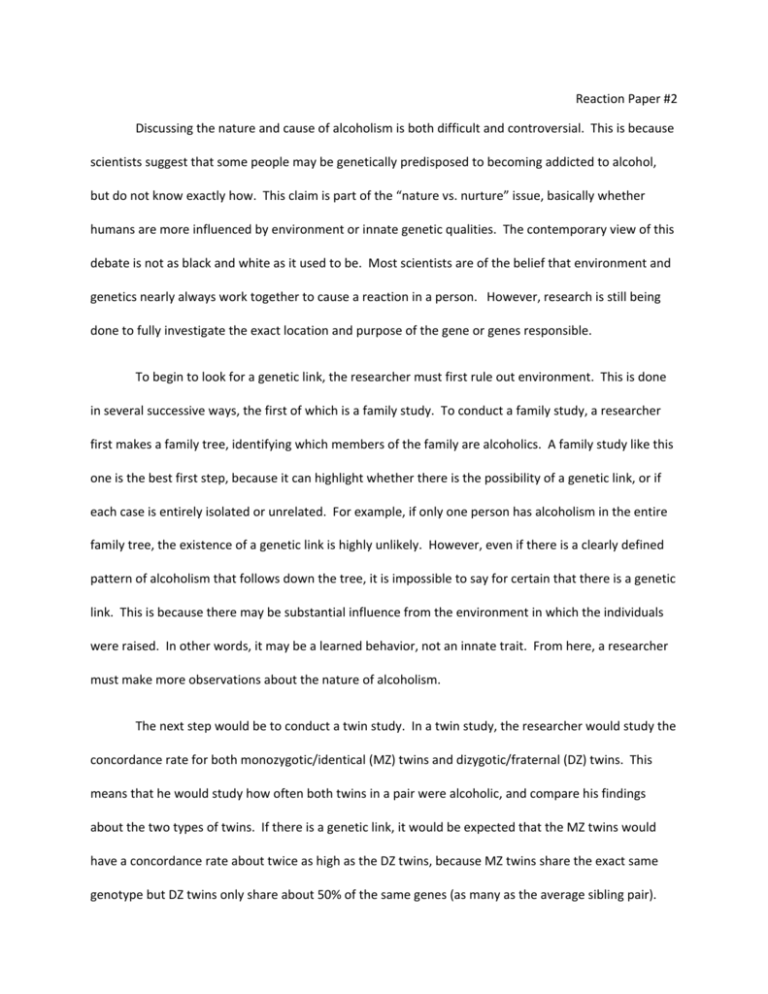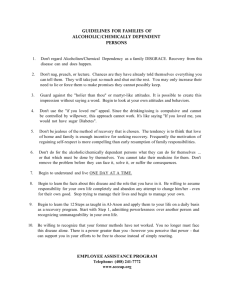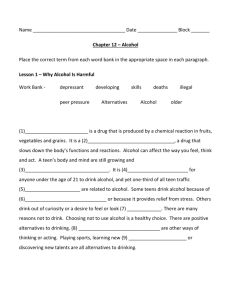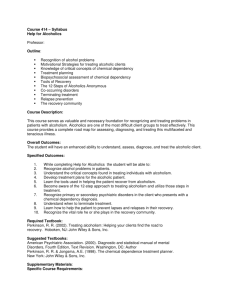reaction paper 2
advertisement

Reaction Paper #2 Discussing the nature and cause of alcoholism is both difficult and controversial. This is because scientists suggest that some people may be genetically predisposed to becoming addicted to alcohol, but do not know exactly how. This claim is part of the “nature vs. nurture” issue, basically whether humans are more influenced by environment or innate genetic qualities. The contemporary view of this debate is not as black and white as it used to be. Most scientists are of the belief that environment and genetics nearly always work together to cause a reaction in a person. However, research is still being done to fully investigate the exact location and purpose of the gene or genes responsible. To begin to look for a genetic link, the researcher must first rule out environment. This is done in several successive ways, the first of which is a family study. To conduct a family study, a researcher first makes a family tree, identifying which members of the family are alcoholics. A family study like this one is the best first step, because it can highlight whether there is the possibility of a genetic link, or if each case is entirely isolated or unrelated. For example, if only one person has alcoholism in the entire family tree, the existence of a genetic link is highly unlikely. However, even if there is a clearly defined pattern of alcoholism that follows down the tree, it is impossible to say for certain that there is a genetic link. This is because there may be substantial influence from the environment in which the individuals were raised. In other words, it may be a learned behavior, not an innate trait. From here, a researcher must make more observations about the nature of alcoholism. The next step would be to conduct a twin study. In a twin study, the researcher would study the concordance rate for both monozygotic/identical (MZ) twins and dizygotic/fraternal (DZ) twins. This means that he would study how often both twins in a pair were alcoholic, and compare his findings about the two types of twins. If there is a genetic link, it would be expected that the MZ twins would have a concordance rate about twice as high as the DZ twins, because MZ twins share the exact same genotype but DZ twins only share about 50% of the same genes (as many as the average sibling pair). This step is also useful in determining whether or not there might be a genetic cause. However, the researcher still cannot rule out the environment, because of variables like how hard the parents tried to make the children have separate personalities. In addition, any similarities in traits may be due to shared environment rather than shared genes. More research is needed. The logical next step would be to conduct adoption studies. In this type of study, a researcher will compare adopted children to both their adoptive parents and biological parents. If the link is genetic, then a child should more closely resemble her biological parents than her adoptive ones. This type of observation is effective in outlining and clarifying further whether there may be a genetic cause for alcoholism, because it removes the possible interference of environment. That is to say, there would be no way for the child to learn alcoholism from her parents, since she didn’t live with them. She lived with her adoptive parents, who don’t share her genes. However, it is still too early to definitively say that the cause is genetic. The researcher should next turn to studies of MZ twins raised apart from each other. Because there are so few documented cases, this study is not very reliable, but it can be very helpful in making a case for a genetic predisposition to alcohol. It can tell you the most about the genetic or environmental influences on alcoholism. The researcher would compare the two separated twins, and examine how similar each pair is. If both twins develop alcoholism in completely different environments, the probability of a genetic factor is likely. This method is so valuable because it entirely removes the variable of environment from the scenario. Also, since they share all the same genes, comparison between the two is almost perfect. However, even if all of the researcher’s findings seem to indicate a gene for alcoholism, all of the results thus far are inconclusive until backed up with an experiment. To create an experiment to better analyze the genetic influence on alcoholism, the researcher should first examine the DNA of various people – alcoholic or not, and look for a gene common among the alcoholics. DZ twins who are not both alcoholic or non-­‐alcoholic can be especially helpful in this context, since comparing the two and finding where they are dissimilar may expedite the process. Once a possible gene has been located or identified, researchers should experiment with gene inhibitors in rats. If the use of gene inhibitors can make the rats alcoholic or non-­‐alcoholic, then it is likely that the gene the researcher identified is responsible for predisposition to alcoholism. This type of study (experimental) is the only kind that allows researchers to define a cause/effect relationship, because they are able to manipulate and control variables that are impossible or unethical to control in real life. Researchers suggest that there are two types of alcoholism. Type 1 occurs equally frequently in men and women, generally appears later in life, and can be characterized by the individual’s anxious nature and tendency to drink to relax. Type 2 occurs in men only, and is early-­‐onset. It is characterized by steady drinking all the time and individuals seem to be risk-­‐seeking, distractible, and easily bored. Further research suggests patterns in the heredity of each type. The individuals studied were adopted children whose biological parents were either type 1 or type 2 alcoholic. If the child was a daughter of a type 1 alcoholic, then that child had a 3 times greater risk of becoming a type 1 alcoholic, regardless of her home situation. If one of the girl’s parents were a type 2 alcoholic, however, there was no increased risk of becoming a type 2 alcoholic. Results were different for the males studied. If the child was the son of a type 1 alcoholic, there was no greater risk of becoming a type 1 alcoholic if he was raised in a non-­‐alcoholic home. But if one of his parents were a type 2 alcoholic, his risk of becoming a type 2 alcoholic was 9 times greater, regardless of his home situation. These findings suggest a strong genetic influence on how and if a child will become an alcoholic later in life, based on the tendencies of his or her parents.






